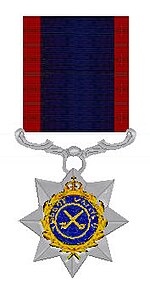| Indian Order of Merit | |
|---|---|
 Indian Order of Merit (2nd Class, Military Division) (top) Ribbon (bottom) | |
| Awarded by the British monarch | |
| Type | Military decoration |
| Established | 1837 |
| Eligibility | Indian citizens in the armed forces and civilians (civilian division) |
| Awarded for | Gallantry |
| Status | Discontinued in 1947 |
| Post-nominals | IOM |
| Precedence | |
| Next (higher) | Victoria Cross |
The Indian Order of Merit (IOM) was a military and civilian decoration of British India. It was established in 1837, (General Order of the Governor-General of India, No. 94 of 1 May 1837) [1] although following the Partition of India in 1947 it was decided to discontinue the award and in 1954 a separate Indian honours system was developed, to act retrospectively to 1947. For a long period of time the IOM was the highest decoration that a native member of the British Indian Army could receive and initially it had three divisions. This was changed in 1911 when Indian servicemen became eligible for the Victoria Cross. A civilian division of the IOM also existed between 1902 and 1939, however, it was only conferred very rarely.
